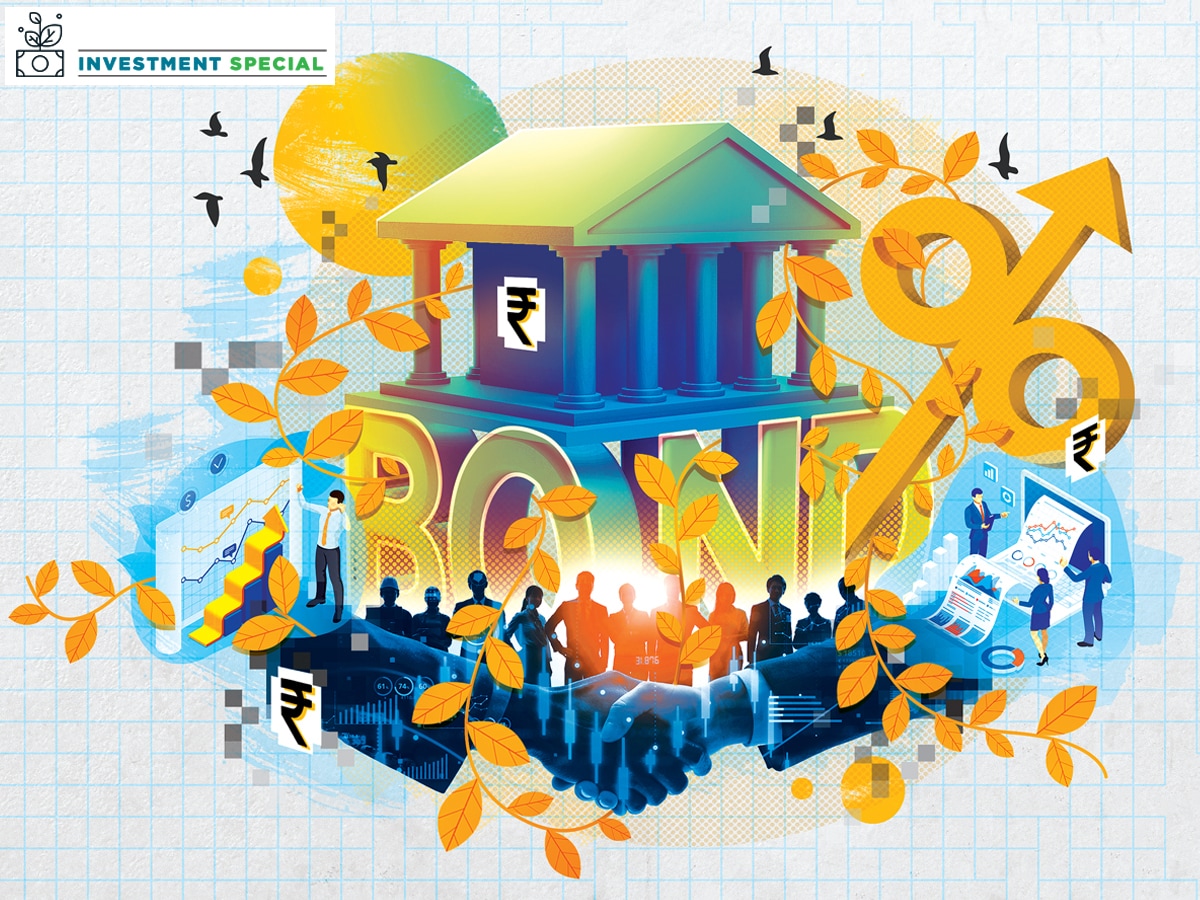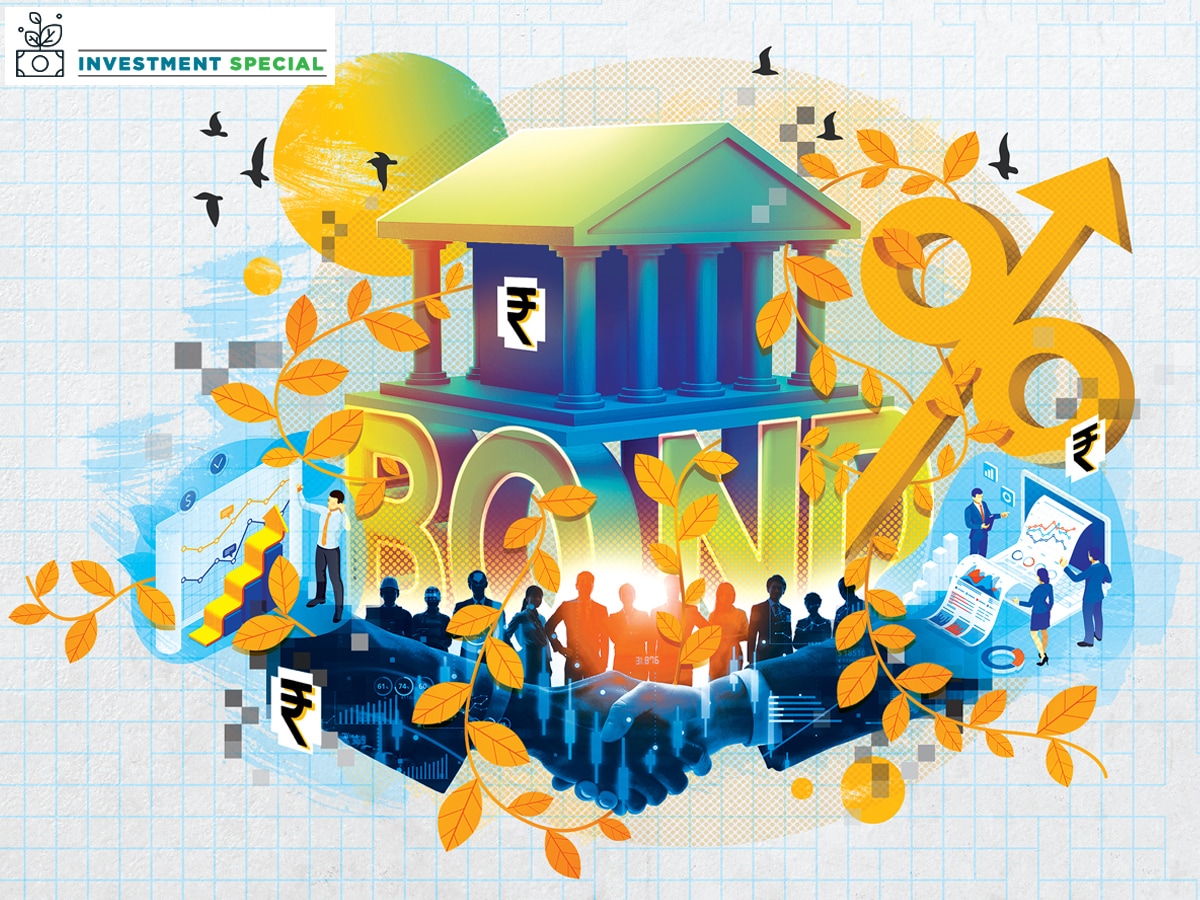 Indian debt investors have a wide and deepening market for both government and corporate bonds to choose from.
Indian debt investors have a wide and deepening market for both government and corporate bonds to choose from.
Photo imaging: Chaitanya Dinesh Surpur
Over the past 18 months bond investments have checked off most boxes investors look for. Double digit returns? Check. Low volatility? Check. Safety of principal? Check. With their downside protected, it’s not hard to see why buying bonds is a deal few should refuse in 2025.
A key reason for this is that interest rates have stayed high in both the US and India. The US 10-year bond yield—considered a proxy for the global risk-free rate—has ranged between 3.6 and 5 percent in 2024. As a result, all debt investments are yielding more globally. And even with rates expected to come down, the consensus, for now, is that they will settle in the 3 percent range. Expect bonds yields to remain elevated.
Closer home in India the situation is the same. The 10-year government bond yields 6.9 percent. On the other hand equities (Nifty 50) are priced at 22 times, implying an earnings yield of 4.5 percent. With GDP slowing down to 5.4 percent in Q2FY25, betting on a continued equity rally may prove to be a fool’s errand.
“With a one-two year time horizon, the risk reward equilibrium has shifted from equities to debt,” agrees Hemant Daga, co-founder and CEO at Neo Asset Management who runs three regular income strategies with a three-month to five-year time horizon.
Indian debt investors have a wide and deepening market for both government and corporate bonds to choose from.
The total outstanding stock of bonds in India is $2.69 trillion, of which corporate bonds make up $592 billion, according to data from the Clearing Corporation of India and the Securities and Exchange Board of India (Sebi).
Globally, bond markets are usually 1.2-1.3 times the size of GDP, implying that the outstanding stock of Indian bonds could double from here on.
Lastly, while the tax treatment of equites remains favourable when compared to debt, the changes in the tax laws in 2023 meant that all forms of debt investing were brought on par.
While earlier only fixed deposits were taxed at the marginal rate, now government and corporate bonds, mutual funds and alternatives investment funds (AIFs) are all taxed at the marginal rate. (The only exception remains hybrid funds that invest in both debt and equity.) An expected turn in the interest rate cycle and the high yields being offered for certain debt investments make it a good time for investors to look at this.
Also read: Bonds play: FII money into Indian debt market fizzling out again
A Spurt in Issuances
As the global interest rate cycle started turning May 2022 onwards, India’s banks went from an excess of liquidity to a deficit. Interest rates were raised a total of 250 basis points and banks struggled to raise deposits. As a result, banks were able to pick and choose who they wanted to lend to.
“Currently the wholesale debt market for mid-sized companies is undersupplied with capital as banks and other financial institutions largely do retail lending and to large highly-rated companies,” says Daga.
As retail lending remained strong, banks went slow on wholesale lending, leading to a spurt in yields on corporate bonds. “Corporate bonds is the segment that reacts most to liquidity unlike government bonds that can be refinanced easily,” says Amit Tripathi, CIO, fixed income at Nippon India Mutual Fund.
Also, the Reserve Bank of India (RBI) prohibits banks from lending for special situations, one-time settlement, loan elongation and so on. Corporate bond issuances surged from ₹9,220 crore in 2023-24 to ₹19,167 crore in 2024-25 according to data from Sebi.
At the same time, regulatory changes made it easier for retail participation in corporate bonds. Hitherto, the minimum ticket size was ₹1,00,000, making it possible only for individuals with a certain net worth to invest. In June 2024 this was brought down to ₹10,000. (For retail participation in government bonds the RBI already has an app.)
Secondly, Sebi started providing an online bond platform provider (OBPP) licence for entities dealing in listed bonds. Goldenpi, an online bond selling platform, has seen its throughput increase to ₹100 crore a month on account of these changes, according to founder Abhijit Roy.
Rates Holding Up
While government bond (10-year) yields have been at 6.75-7 percent for investors willing to play the rate cycle, there are several attractive offerings to choose from. Investors buying paper from companies that are AA rated sell their paper for 9-10 percent a year. An A rated corporate or NBFC would likely offer 10-12 percent a year and a BBB rated NBFC would offer upwards of 12 percent. Below BBB is generally considered uninvestible.
This has also been a period when corporate India has deleveraged, and with gearing levels across companies being low the risk of a default is lower. “While these companies are susceptible from a profitability perspective to economic cycles, strong capitalisation and very low leverage levels help them absorb any such cyclical risk,” says Tripathi.
Take for instance Spandana Sphoorty, which has seen its profitability collapse due to the microfinance cycle turning for the worse. Still, its interest payouts have not been impacted even though the stock has slid by 73 percent in the last 12 months. The fact that its balance sheet is geared only 2 times gives investors the confidence that it will continue to service its debt obligations. Its bonds trade at 10-75-11 percent.
With rates at 9-12 percent, a change in the rate cycle could prove to be a one-time boon for investors. It is likely that they would outperform government bonds over a 12-month time frame. A point to note is that long-dated corporate bonds that mature in 7-10 years and yield 10-12 percent could see payouts of more than 10 percent in a year if interest rates start coming down.
Keep in Mind
While these yields may be enticing to investors and it is true that the vast majority of bonds pay interest on time, one needs to note that several unlisted companies offering bonds do not have coverage and so gathering information on them becomes a challenge.
Also, when one goes down the rating curve, the risk of default is not linear. It accelerates as one goes down the rating curve. “You should not be taking equity level risk while playing for fixed income returns,” says R Sivakumar, head, strategy and products at Axis Mutual Fund.
While purchasing corporate bonds online and receiving interest payments is as easy as a click of a button, all participants acknowledged that there exist no liquid markets for these securities and platforms only pledge to sell them on a best-effort basis. They all advise investors to hold these instruments till maturity.
And there is also the chance that the rate cycle may take longer than anticipated to reverse during which time the equity markets may become attractive. If one prefers low volatility, low risk with principal protection Indian bonds offer a good entry point at the moment. It would pay to allocate a portion of funds here.
(This story appears in the 24 January, 2025 issue
of Forbes India. To visit our Archives, click here.)
